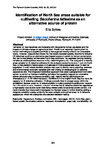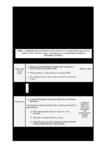Identification of North Sea areas suitable for cultivating Saccharina latissima as an alternative source of protein
| dc.contributor.author | Sykes, E. | |
| dc.date.accessioned | 2022-12-23T19:28:40Z | |
| dc.date.available | 2022-12-23T19:28:40Z | |
| dc.date.issued | 2022 | |
| dc.identifier.citation |
Sykes, E. (2022) 'Identification of North Sea areas suitable for cultivating Saccharina latissima as an alternative source of protein', The Plymouth Student Scientist, 15(2), pp. 320-357. | en_US |
| dc.identifier.issn | 1754-2383 | |
| dc.identifier.uri | http://hdl.handle.net/10026.1/20112 | |
| dc.description.abstract |
Demands for food resources are increasing with the growing human population and the impacts of climate change on agricultural land. Protein is an essential macronutrient for human well-being and supplies are likely to face a global security crisis in the foreseeable future. However, research has shown that the brown seaweed species Saccharina latissima (S. latissima) could be an alternative plant-based source of protein for human consumption that can be sustainably farmed under North Sea conditions. Yet seaweed farming currently remains an underexploited resource in the United Kingdom (UK). This study aims to identify areas suitable for S. latissima cultivation in the exclusive economic zone of England’s North Sea, to help decision-makers adapt to challenges in finding sustainable ways to feed the population. A multi-criteria decision analysis was used to identify twenty planning, technical and environmental constraint variables and their criteria for developing an S. latissima aquaculture site. The integrated methodical approach then used a geographical information system to perform a Boolean modelling technique that spatially mapped out constraints across the study area to create a suitability map. Results identify and illustrate the whereabouts of ∼2.05 million hectares (∼20,500km2) in the English North Sea that have the capacity for S. latissima cultivation. Findings conclude there is enough scope within the established Boolean areas for S. latissima yields to make meaningful contributions towards the UK’s protein supply. However, analysis indicated that S. latissima should be regarded as a high-quality food source rather than being viewed solely for potential protein content. It is recommended that future work investigates the Boolean areas in further detail by adding a weighted suitability overlay to identify between suitable and optimal areas for S. latissima aquaculture, which will strengthen site selection decision-making. | en_US |
| dc.language.iso | en | en_US |
| dc.publisher | University of Plymouth | en_US |
| dc.rights | Attribution 3.0 United States | * |
| dc.rights.uri | http://creativecommons.org/licenses/by/3.0/us/ | * |
| dc.subject | Aquaculture | en_US |
| dc.subject | Boolean | en_US |
| dc.subject | cultivation | en_US |
| dc.subject | GIS | en_US |
| dc.subject | macroalgae | en_US |
| dc.subject | MCDA | en_US |
| dc.subject | North Sea | en_US |
| dc.subject | plant-based protein | en_US |
| dc.subject | Saccharina Latissima | en_US |
| dc.subject | seaweed | en_US |
| dc.subject | site selection | en_US |
| dc.subject | sugar kelp | en_US |
| dc.subject | sustainability | en_US |
| dc.subject | UK | en_US |
| dc.title | Identification of North Sea areas suitable for cultivating Saccharina latissima as an alternative source of protein | en_US |
| dc.type | Article | en_US |
| plymouth.issue | 2 | |
| plymouth.volume | 15 |




